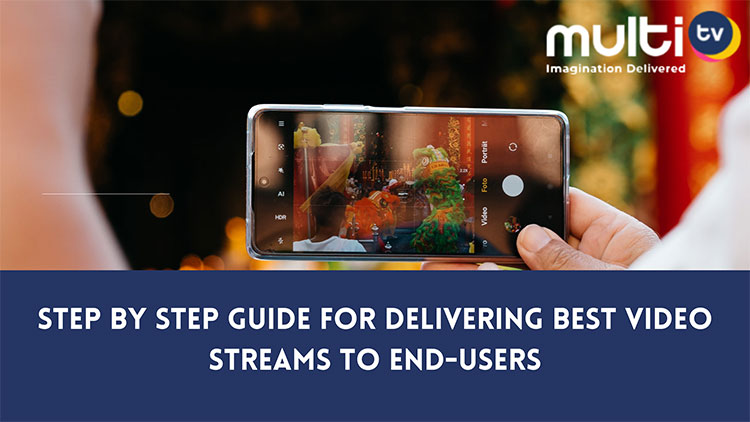It’s no secret that streaming video is on the rise. In order to keep up with demand, OTT platforms and broadcasters need to ensure they’re delivering the best possible video streams to their end-users. This guide will walk you through the basics of setting up and delivering high-quality video streams to your viewers. So whether you’re a seasoned pro or just starting out, read on for some tips that will help you take your streaming to the next level.
Let’s get started!
Some quick steps to deliver a high-quality video experience to your end-users
Delivering video streams to users is an increasingly complex task, as viewers demand ever-higher quality and more reliable streaming. In order to deliver better video streams to end-users, content providers need to employ a number of strategies, including:
- Employing a content delivery network (CDN) can help optimize and distribute your video content.
- Using adaptive bitrate streaming can adjust the quality of your video stream based on the viewer’s connection speed.
- Make sure your server infrastructure is up to the task of streaming video content by employing adequate bandwidth and CPU resources.
- Use video encoding techniques that minimize buffering and deliver the best possible video quality at the lowest possible bit rate.
- Regularly monitor your video streams for quality issues and take steps to address them.
How encoder setting plays a role
When encoding video for streaming, it’s important to choose the right encoder settings to deliver the best possible quality at the lowest possible bitrate. There are a number of factors to consider when making this choice, including the type of content, the target bitrate, and the viewer’s connection speed.
Additionally, using video encoding techniques that minimize buffering and deliver the best possible video quality can help improve the viewer experience. Regularly monitoring your video streams for quality issues and addressing them promptly can also help ensure that viewers are getting the best possible experience.
It’s important to remember that delivering better video streams to end-users is an ongoing process. As viewer demand evolves, so too must the strategies and techniques employed by content providers. By staying abreast of new developments and taking advantage of emerging technologies, content providers can continue to deliver the high-quality, reliable streams that viewers expect.
What is Adaptive Bitrate (ABR) Technology and how does it helps in transcoding

ABR technology helps content providers to deliver better video streams to end-users by automatically adjusting the bitrate of the video stream based on the viewer’s connection speed. This ensures that viewers always receive the best possible quality video stream, without having to wait for buffering or other interruptions. Additionally, ABR technology can help content providers save on bandwidth costs by reducing the need to transcribe video at multiple bitrates.
Configuring Multiple CDNs for Ultra-Fast Video Playback
Content delivery networks (CDNs) are a key component of delivering better video streams to end-users. CDNs help to optimize and distribute your video content, ensuring that viewers always receive the best possible quality stream. Additionally, CDNs can help reduce the load on your server infrastructure, freeing up resources for other tasks.
Configuring multiple CDNs can help improve the video playback experience for end-users by providing a more resilient and redundant streaming infrastructure. By using multiple CDNs, content providers can ensure that videos are delivered more quickly and reliably, even under high traffic conditions.
Additionally, using multiple CDNS can help reduce latency and improve video quality. By spreading traffic across multiple CDNs, content providers can ensure that viewers always receive the best possible quality video stream.
Configuring multiple CDNs can be a daunting task, but there are a number of tools and services available to help content providers get started. Once configured, multiple CDNs can provide a significant improvement to the video streaming experience for end-users.
How to ensure your video streams are high quality and reliable
In order to ensure that your video streams are high quality and reliable, it’s important to employ a number of strategies, including:
- Start with load testing – Check the performance of your streaming website & apps, and identify potential weak points in architecture.
- Test video initial quality levels – Ensure that they are up-to-code for both latencies (incoming) as well CDN performances(outgoing).
- Monitor network congestion issues closely – This could be what causes slow scrolling or buffering times when users can’t get enough bandwidth during peak hours even though you have plenty available at home!
- Using video encoding techniques – It minimizes buffering and delivers the best possible video quality.
Regularly monitor your video streams for quality issues and address them promptly.
Continuous monitoring of streaming quality
Content providers need to be vigilant in monitoring their video streams for quality issues. By identifying and addressing problems promptly, providers can ensure that viewers are getting the best possible experience.
One way to monitor streaming quality is to use a tool like GoSquared or Google Analytics. These tools allow content providers to see how much bandwidth their videos are using, as well as identify where viewers are dropping off. Additionally, content providers can use these tools to track which videos are being watched the most and make changes accordingly. Another way to monitor streaming quality is to use a tool like New Relic or AppDynamics. These tools provide detailed information about your server infrastructure, including response times and error rates. By monitoring your servers, you can identify and address potential problems before they impact end-users.
Conclusion
Delivering better video streams to end-users is an important goal for all content providers. By employing strategies like adaptive bitrate transcoding and configuring multiple CDNs, content providers can ensure that their videos are delivered quickly and reliably. Additionally, regular monitoring of streaming quality can help identify and address problems before they impact viewers. By taking these steps, content providers can ensure that their videos are always high quality and reliable.

